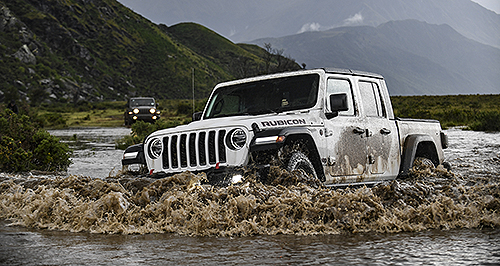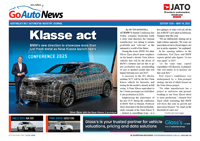News - Jeep - GladiatorGladiator more than just a Wrangler ute: JeepJeep Gladiator and Wrangler have lots in common, but ‘they’re cousins, not brothers’15 Jan 2020 By BYRON MATHIOUDAKIS in NEW ZEALAND JEEP hopes that consumers see the upcoming Gladiator dual-cab 4x4 pick-up truck as not just a sawn-off Wrangler with a tub stuck on the back, but rather as a distinct model in its own right.
“Yes, it is definitely sharing a lot of components with the Wrangler, its DNA,” said Jeep global president Christian Meunier, fronting media at the JT Gladiator international launch in New Zealand.
“But at the same time, they are not brothers, they are cousins. There is a lot of difference between the Wrangler and the Gladiator.”
Lead exterior designer Taylor Langhals, who has worked on the current Grand Cherokee among other Jeeps, said Gladiator design studies started in earnest in 2015, which was 12-18 months after the JL Wrangler styling was completed.
Though everything behind the B-pillar is new, Mr Langhals took the opportunity to differentiate the two models by creating a slightly altered grille and front guards.
Classic brand design elements can be found in the 1945-1986 CJ (Civilian Jeep) round headlight treatment and 1996-2006 TJ Wrangler’s trapezoidal grille and mudguards. All are visual departures from the latest JL Wrangler.
There was much discussion on exactly how long the load bed would be, and when it was decided that two trail bikes had to fit – and that 95 per cent of all motorcycles must be accommodated – in keeping with the lifestyle adventure-seeking aspirations of the target audience, a 500mm-longer wheelbase was settled upon.
Off-road clearance needs also dictated that the spare wheel be relocated and slung just behind the rear axle. Further back, a square tail-light motif us used – “Otherwise it’s not a Jeep,” said Mr Langhals – while their dinky sizing is a result of the width of the tailgate aperture.
The cabin, too, checks in with Jeeps of yesteryear, with the Gladiator – like the Wrangler – adopting the horizontal fascia themes evident from the 1941 Willys MB (Military Model B) right through to the ’96 TJ. After that the Wrangler switched to a vertical dash look with the centre console dominating, until the previous-generation JK Series II facelift in 2011.
Other heritage-inspired details inside include the three-pointed ‘horns’ etched out of the steering wheel boss centre ring recalling the spindly three-spoke item found in the wartime Jeep.
Meanwhile, the Wrangler’s coil-sprung rear suspension system was binned for the set-up employed beneath the Dodge Ram 1500 pick-up trucks. While sharing the same upper and lower control arms, the Gladiator’s gains a completely unique tune, and features forward-facing Fox shock absorbers.
According to Jeep brand engineering head Elizabeth Krear, who joined Jeep from Ram in 2018, the Gladiator was subjected to identical shakedown testing during development.
“All our vehicles undergo exactly the same level of vigorous testing,” Ms Krear told GoAuto. “It didn’t skip any steps. After all, on a development trip, you often find you might want to tweak something (unique to that vehicle).”
The 31-year Chrysler mechanical engineering veteran nominated marrying the Wrangler front structure to the Ram truck rear proved to be one of the more challenging aspects, especially as it involved re-engineering the Ram’s rear axle to the centre of the box to accommodate the aforementioned spare wheel.
“That also need to be package-protected for larger wheels so it uses lots of space,” she added.
Asked if the Gladiator is seen as a threat to Ram’s business, Ms Krear believes the demographics are too wide apart.
“There are no concerns that Gladiator would be stepping on Ram’s toes, because they’re completely different customers,” she said. “The Ram is clearly designed for maximum heavy-duty towing … while the Gladiator customer is a lifestyle customer and wants to play with his or her toys.”
The latter also informed the decision to go with a four-door, five-seater dual-cab layout.
“We launched with the four-door because we think this is the right cab configuration for the customer,” Ms Krear said.
One of the more satisfying engineering tasks was devising rear-seat packaging that could accommodate hidden, lockable storage due to the open-top nature of the Gladiator that might require such security.
The rear backrests fold down and are lockable when erect again for this reason, while the seatbelts are not mounted on the seats themselves so they allow for a clean drop.
A single-handed folding action via a lever on the headrest was also created, while another pair of compartments live beneath the rear seat cushions.
Finally, the Gladiator was engineered with customisation and personalisation front of mind, and includes a Bluetooth wireless speaker known as the ‘Boom Box’ located within the rear-seat structure. It is climate proof, waterproof, tough and rechargeable when returned in situ.
“The open-air feeling is my favourite part of the Gladiator,” Ms Krear revealed. “And that our obsessive attention to detail means there isn’t really something I can think of that we’ve left undone.”  Read more15th of January 2020  First drive: Jeep takes own path with Gladiator uteStrong 4x4 capabilities mix with Wrangler style in Jeep’s unique American pick-up17th of December 2019  Diesel delay for Jeep GladiatorJeep’s all-new Gladiator dual-cab ute will stick with Wrangler petrol V6 for now10th of December 2019  Jeep boss talks up PSA merger‘A lot of synergies’ in planned FCA-PSA merger, says Jeep global president10th of December 2019  Jeep resets for sustained 2020 recovery‘Holistic approach’ changes planned to reverse Jeep’s Australian sales slide10th of December 2019  Jeep thinks big againStrategy overhaul for Jeep in Australia targets 50,000 sales a year for long haul21st of May 2019  Australia to be second largest Jeep Gladiator marketDue by mid-2020, Jeep’s Gladiator will kick off in high-spec ‘launch edition’ guise9th of April 2019  Gladiator dominates Easter Jeep Safari conceptsSix off-road concepts based on old and new Jeep Gladiator pick-up make their debut4th of December 2018  LA show: Jeep Gladiator’s design challengesJeep designers and engineers overcome hurdles to produce Gladiator pick-up |
Click to shareJeep articlesResearch Jeep Motor industry news |
















Facebook Twitter Instagram